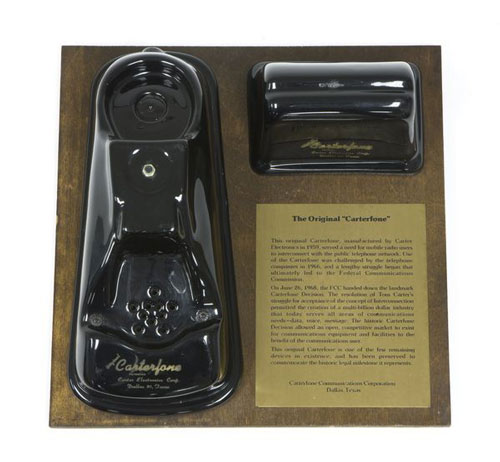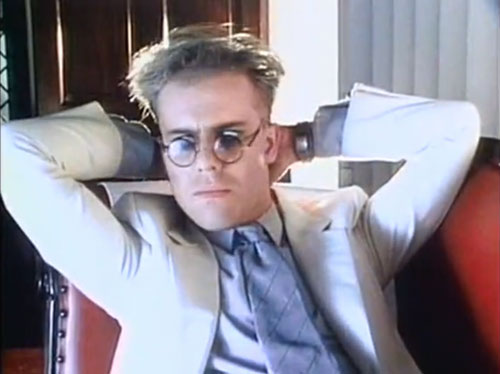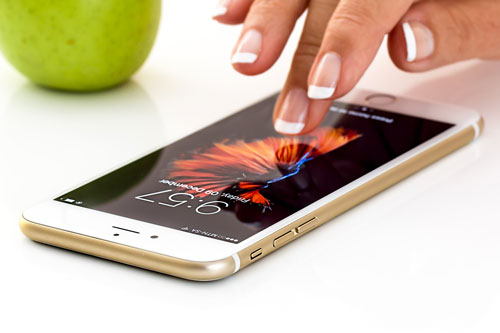The Polyphonic Screed
The evolution of the modern cell phone ringtone—and the Ukrainian guy who wants to give Apple’s default noises a refresh.
Today’s GIF comes from a 1994 Nokia commercial.
Sponsored By … You?
If you find weird or unusual topics like this super-fascinating, the best way to tell us is to give us a nod on Ko-Fi. It helps ensure that we can keep this machine moving, support outside writers, and bring on the tools to support our writing. (Also it’s heartening when someone chips in.)
We accept advertising, too! Check out this page to learn more.
1902
The year that Spanish guitarist Francisco Tárrega first composed “Gran Vals,” a solo guitar composition that inspired the iconic “Nokia Tune” after the company’s engineers were looking for a suitable ringtone for its line of cellular phones. The musical passage, which would become one of the world’s most-heard pieces of music, was pulled into Nokia’s devices in part because it was in the public domain—Tárrega had been dead for about 80 years by the time they sampled the song as a ringtone. That said, while Tárrega’s guitar playing was the clear inspiration for the ringtone, The Next Web noted in 2011 that the original version of the composition was created by Fréderic Chopin in his “Grand Valse Brillante,” though it’s not obvious due to the two compositions being played on different instruments and in differing contexts. You may be able to make it out here.

The Carterfone didn’t produce ringtones, but a regulatory decision enabled the first devices that did. (Courtesy of Scott Brear/Computer History Museum)
Two key touch points in the evolution of the modern ringtone
Though the success of “Crazy Frog,” the animated amphibian associated with the unavoidable 2005 hit “Axel F,” might make you think otherwise, the ringtone didn’t necessarily start with the cell phone—though, certainly, that was the logical conclusion.
It certainly didn’t thrive until the cell phone era, but the the inspiration point for the ringtone as we know it today likely goes back to at least the 1970s, when a regulatory decision made novelty gadgets possible. In 1968, the Federal Communications Commission ruled that equipment that wasn’t made by Bell could be used to connect to the telephone system. The decision came up because of a device called the Carterfone, which made it possible to connect a telephone line to a private two-way radio system.
The ruling, which AT&T fought tooth and nail, was far more significant than it seemed at the time, as it made it possible for third-party companies to offer long-distance service, something MCI first offered the in 1970.
Another, less heralded side effect of the ruling was that it allowed for the use of devices that created novelty ringtones. The Tele-Tune, produced by Interconnect Telephone of Canada around 1981, focused its ringtones on the caller, not the recipient; it used chips to play up to eight tunes in place of the ringing you might expect otherwise.
(It could be argued that answering machines were the ringtones of their day, and much work went into customizing those, as Phone Losers of America graciously recalls.)
Around the time that these devices were starting to appear on shelves, a British musician named Thomas Morgan Robertson was working on his debut album, The Golden Age of Wireless, a name in reference to radio, not cell phones. You might know the guy as Thomas Dolby. It’s a rather ironic album name given the second stage of his career.

Thomas Dolby, as seen in his most famous music video.
Dolby, a masterful synthpop musician whose hit “She Blinded Me With Science” was just a small glimpse of his talent, later played an important role in the evolution of the ringtone—he added lots of depth to the sounds that standard cell phones could make.
As Dolby noted in a 2005 interview with The A.V. Club, he stumbled into the ringtone space because of a piece of software his company, Beatnik, had created. The technology was intended as a website plugin not unlike Flash or Java, but it checked off most of the marks for working in simplistic cell phones.
“When the whole dot-com crash happened, what Beatnik was left with that wasn’t a bunch of fluff was a contract with Nokia, who were looking to put polyphonic ringtones into phones,” Dolby explained to the news outlet. “Sort of by accident, the requirements for Web audio-software technology were not that dissimilar to what Nokia needed, because we’d made a software-based audio engine that could be downloaded very quickly and used files like MIDI files, but which had good fidelity because they could include actual samples of recordings.”
Beatnik’s strategy was effective because of how it worked—it was a software solution to a problem that other cell phone makers were trying to solve with hardware chips that cost a lot of money. Nokia, which used monophonic sounds previously, was looking to add more layers of depth to the tones coming out.
Dolby’s solution was so effective that every major cell phone company of the pre-smartphone era licensed the software after Nokia had success with it.
“Everybody licensed the Beatnik engine,” Dolby said at the time. “It’s the predominant ringtone in the world.”
This licensing opened up an opportunity for the record industry to make money from digital music—something still not entirely clear as a path in 2001 or so—particularly outside of the U.S. According to Dan Steinbock’s The Mobile Revolution: The Making of Mobile Services Worldwide, the Japanese and European markets particularly gravitated to the ringtone model, while the U.K. industry took steps to protect a budding market from piracy.
“The music industry doesn’t want another Napster-type situation to develop and is starting to crack down on such sites,” Ben Coppin of the anti-piracy firm Envisional noted in 2001.
$300M
The estimated size of the mobile music market in the U.S., according to a 2004 press release announcing the launch of Billboard’s Hot Ringtones chart, which highlighted the most popular ringtone downloads. (A New York Times piece from a year later doubled the size to $600 million.) It’s a market that would not have existed had Thomas Dolby not sold Nokia on its polyphonic ringtone technology. “Billboard charts have long held an independent and authoritative role in influencing sales of recorded music, whether it be a physical or digital format,” Billboard’s then-publisher, John Kilcullen (who, side note, is also the guy who came up with the idea for the “For Dummies” series of books), said in the release. The company published the ringtone chart until 2014; it’s the one place where Taylor Swift’s “Shake It Off” is still on top.
This guy doesn’t own an iPhone, but he thinks Apple needs new ringtones
For weeks, Slavio Pole, a Ukrainian musician and sound engineer, has been on a Twitter-based quest: He wants Apple to consider using his ringtones for its iPhones—and ditch the ones it currently has.
Perhaps it seems like a fruitless, tilting-at-windmills kind of situation (he has just four followers at the time I write this, and one of them is me), but his reasoning is sincere and totally valid even if his ask is a bit unusual.
“We want the best to become perfect,” Pole explains in a video that shows him dropping a flash drive into a letter addressed to Apple’s headquarters in Cupertino, California. (He says he actually mailed two—one to Tim Cook, one to Craig Federighi.)
So what’s wrong with Apple’s current sounds? In an interview, he explained his thought process was driven by the seemingly in-stasis nature of ringtones on Apple devices.
“I think that most of the ringtones on the iPhone have a sharp sound,” he told me in an email. “I checked all the sounds in the iPhone and I can conclude that many ringtones and sounds are superfluous and incomprehensible.”
The point that these sounds—which are everywhere, blaring from the purses of inconsiderate theatergoers and train passengers and on the bedsides of people waking up first thing in the morning—annoy Pole is particularly notable, because he doesn’t own an iPhone, and nor do most of his friends.
“Yes, unfortunately in Ukraine [people] do not appreciate creative work with dignity, so not everyone can afford to buy an iPhone,” he explained.
This is not uncommon in the country; as mobile operating systems go, iOS has a marketshare of 19.1 percent percent in Ukraine according to Statcounter, compared with 53.4 percent in the United States. Part of the reason for this, according to the local TV channel 112 Ukraine, involves higher taxes than other parts of the world. Asbis, an electronics retailer that serves the Ukranian market, has a starting price of around $944 USD for the iPhone 8, around $255 more than the American base price.
Pole, who has played music in bands and worked professionally in sound engineering for about 15 years, saw an opportunity to solve a basic wrong he heard on a daily basis, and he recorded lots of tiny compositions with the help of collaborators Iryna Tuzenko and Sergey Sitnyk—a mobile phone production team called ZEPHYR.
Of the many sounds ZEPHYR has created, from bubble-popping sounds designed for iMessage to a soothing ring called “Evening Mystery,” perhaps my personal favorite is one called “Azure Coast,” a piano-and-guitar ditty, intended as an alarm, that sounds significantly less abrasive than most of Apple’s own noises. It has a very minor chord change right near the end that is subtle, but prevents the sound from getting annoying.

(stevepb/Pixabay)
While Apple has tried to evoke this feel in recent years with the “Bedtime” mode it’s offered in recent versions of iOS (leading one YouTuber to create a ten-minute version of its most interesting alarm, “Early Riser”), it’s arguable that Pole’s team has found a softer touch.
Apple’s creative process—whether for big things like its laptops or for tiny things like ringtones—has famously been something of a black box, though there is precedent for technology companies relying on well-known outside musicians to create their sounds. For example, Microsoft gave a lot of money to Brian Eno to create a startup sound for Windows 95, and later paid Robert Fripp to do the same thing for Windows Vista. (And of course, as noted above, Nokia had a deal with Thomas Dolby’s company.)
Even though the strategy isn’t one that Apple seems like it’d be interested in trying, Pole suggests it might want to make an exception in this case, because of just how important these sounds really are.
“I think that companies should rely on outside musicians because it does not matter where you are from or where you live,” Pole told me. “The main thing is that you want to be useful anywhere in the world. Such actions have a social and commercial vector.”
The idea of using a song as a ringtone, while still certainly done, is probably less fashionable than during the days of “Crazy Frog” and Billboard dedicating a chart to them.
Certainly, Dolby had mixed feelings about the fact that his idea eventually gave way to the use of modern pop songs—even though, before Nokia came up with its official sound, that’s exactly what it initially wanted to do.
“Little tiny clips of the latest Adele song going off are just not quite the same,” he told the BBC in 2011. “There’s a certain purity about the polyphonic ringtone that will never be replicated.”
In fact, it’s arguable that lots of folks just leave their ringers off at all times, barring those moments when they use the phones as alarm clocks. The official sound of the cell phone era, for what it’s worth, may actually be vibrate mode.
I asked Slavio Pole about this, as I found it interesting to consider that he put all this work into this beautiful bleeps and bloops that lots of people have conditioned themselves to never even use, lest they have bad memories of the first time they heard Apple’s infamous “Marimba” sound, later updated to the less-infamous-but-still-infamous “Opening.”
“This can lead to a lot of problems,” Slavio argued. “Someone can lose money, someone can lose people they love, and someone can miss a call with a proposal for a million, because they won’t hear the call.”
And of course, there’s the other argument that carries weight even if vibrate mode is on: “People need an alarm clock. Not everyone can wake up on time.”
Tim Cook, Craig Federighi, if you’re reading this, you know what to do: Give Slavio a call.
:format(jpeg)/2018/02/tedium022218.gif)
/2018/02/tedium022218.gif)


/uploads/ernie_crop.jpg)